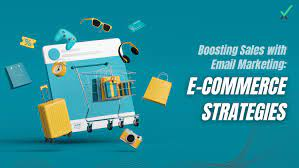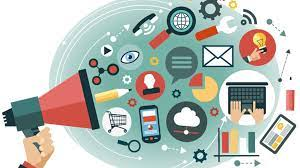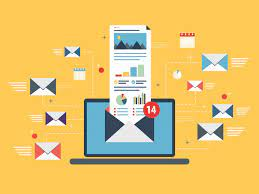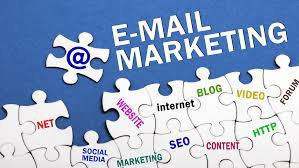E-Commerce Email Strategies: Boosting Sales and Customer Engagement
April 25, 2025
Ron

In the ever-evolving world of e-commerce, email marketing remains a tried and tested strategy for boosting sales and engaging with loyal customers. Crafting effective email campaigns can be the key to success in the highly competitive online marketplace. In this article, we will explore some e-commerce email strategies that can help your business thrive.
1. Segmentation is Key
One of the fundamental principles of successful e-commerce email marketing is segmentation. Segmenting your email list allows you to send targeted marketing messages only to specific groups of subscribers. You can segment based on factors like purchase history, browsing behavior, location, or demographic information. By sending relevant content to the right audience, you increase the chances of conversions.
2. Personalization Drives Engagement
Personalization is more than just using the subscriber’s name in the email. It involves tailoring the content to match the subscriber’s preferences and interests. Personalized product recommendations, content, and offers can significantly boost engagement and sales. E-commerce platforms and email marketing tools often provide personalization features to make this process easier.
3. Abandoned Cart Recovery
Cart abandonment is a common issue in e-commerce. Many customers add products to their carts but leave the website without completing the purchase. Sending a series of well-timed emails with reminders and incentives can help recover these lost sales. Include product images, prices, and a clear call to action to encourage customers to return and complete their purchase.
4. Welcome Series
A welcome email series is a fantastic opportunity to make a great first impression. Use this series to introduce your brand, showcase your best products, and offer a welcome or discount code or incentive. The goal is to engage new subscribers from the get-go and encourage their first purchase.
5. Post-Purchase Engagement
Your relationship with a customer doesn’t end after they make a purchase from online store. A post-purchase email series is a chance to engage further. Send order confirmations, shipping updates, and delivery notifications. After the purchase, ask for reviews and offer related product recommendations.
6. Win-Back Campaigns
Inactive subscribers can be re-engaged with win-back campaigns welcome emails. These emails can offer exclusive discounts, remind subscribers of what they’re missing, and encourage them to return to your website. Remember to analyze the effectiveness of these campaigns and adjust your approach accordingly.
7. Promotional Campaigns

Running regular promotional emails and campaigns can drive sales spikes. Whether it’s a seasonal sale, a flash discount, or a special event, email is an excellent channel for promoting your offers. Craft compelling, eye-catching emails that highlight the value of the promotions.
8. Educational Content
Beyond sales-driven emails, providing educational content can help build trust and loyalty with your subscribers. Create informative blog posts, guides, or videos related to your products or industry. Sharing valuable knowledge positions your brand as an authority and keeps your audience engaged.
9. Mobile Optimization
A significant portion of your subscribers will access their emails on mobile devices. Ensure that your emails are mobile-responsive and look great on various screen sizes. An unoptimized email can deter potential customers from engaging with your brand.
10. A/B Testing
A/B testing is a valuable technique to optimize your email campaigns. Test different subject lines, email content, images, and calls to action to see which elements drive the best results. Over time, these insights can help you refine your email strategies.
E-commerce Email Strategies: Email Marketing Campaigns

Effective email marketing campaigns are a blend of strategy, creativity, and adaptability. By understanding your audience, delivering compelling content, and continuously refining your approach, you can leverage email marketing to foster meaningful connections, drive engagement, and achieve your business objectives.
1. Crafting a Strategic Foundation
Successful email marketing begins with a well-defined strategy. Explore the importance of setting clear objectives, understanding your target audience, and aligning your email campaigns with broader marketing goals. A strategic foundation ensures that each email serves a purpose within the overarching marketing strategy.
2. Building and Segmenting Your Email List
Your email list is the backbone of your campaigns. Learn effective methods for building a quality email list and the importance of segmenting it based on demographics, behaviors, or preferences. Targeted segmentation allows for personalized and relevant content, increasing the likelihood of engagement.
3. Creating Compelling Content
Compelling content is the heart of any successful email campaign. Dive into the elements of creating engaging and valuable content, from attention-grabbing subject lines and concise copy to visually appealing graphics. Tailor your content to resonate with your audience and encourage them to take the desired action.
4. Nurturing Leads through Email Sequences
Email sequences are a powerful way to nurture leads through the customer journey. Explore the concept of drip campaigns and automated sequences, guiding subscribers from awareness to conversion. Well-crafted sequences provide a seamless and personalized experience for your audience.
5. Optimizing for Mobile Responsiveness
With a significant portion of emails being opened on mobile devices, optimizing for mobile responsiveness is paramount. Understand the importance of responsive design, concise layouts, and mobile-friendly content to ensure a seamless experience across devices.
6. A/B Testing for Continuous Improvement
A/B testing is a vital tool for refining your email campaigns. Explore the elements that can be tested, from subject lines and visuals to call-to-action buttons. Iterative testing allows you to uncover what resonates best with your audience and continuously improve your campaign performance.
7. Personalization and Dynamic Content
Personalization goes beyond addressing recipients by their first name. Discover the impact of dynamic content that tailors the email experience based on individual preferences and behaviors. Personalized and relevant content increases engagement and builds a stronger connection with your audience.
Crafting a Winning Email Marketing Strategy
Email marketing remains a cornerstone in the digital marketing landscape, offering a direct and effective way to engage with your audience. Crafting a winning email marketing strategy involves a strategic approach, understanding your audience, and leveraging the power of compelling content.
1. Define Clear Objectives
Begin your email marketing journey by defining clear objectives. Whether it’s increasing brand awareness, driving sales, or nurturing leads, having specific and measurable goals will guide your ecommerce email marketing strategy and allow for effective performance evaluation.
2. Know Your Audience Inside Out
Understanding your audience is at the core of a successful strategy. Create buyer personas to delve into the demographics, preferences, and behaviors of your audience. Tailoring your marketing emails, to resonate with their needs and interests enhances engagement.
3. Building and Segmenting Your Email List
A quality email list is the foundation of your strategy. Implement strategies to organically build your list, and then segment it based on criteria like demographics, behaviors, or past interactions. Segmentation allows for targeted and personalized content delivery.
4. Craft Compelling Content
Compelling content is the driving force behind successful email campaigns. Craft attention-grabbing subject lines, concise and engaging copy, and visually appealing designs. Align your content with your audience’s needs and preferences to create a lasting impact.
5. Establishing a Consistent Sending Schedule
Consistency is key in email marketing. Establish a sending schedule that aligns with your audience’s expectations. Whether it’s a weekly newsletter or monthly promotions, a consistent schedule helps build anticipation and keeps your brand top-of-mind.
6. Implementing Personalization Strategies
Personalization goes beyond addressing recipients by their first name. Implement dynamic content and personalized recommendations based on user behavior. Tailoring your emails to individual preferences fosters a sense of connection and increases engagement.
7. Automation for Efficiency and Personalization
Utilize automation to streamline your email marketing efforts. Automated sequences automated email campaigns, drip campaigns, and triggered emails based on user actions allow for timely and personalized communication. Automation enhances efficiency while maintaining a personal touch.
8. Mobile-Optimized Design
With a significant portion of email opens happening on mobile devices, mobile optimization is non-negotiable. Ensure your emails have responsive designs, concise layouts, and mobile-friendly content for a seamless user experience across devices.
9. A/B Testing for Continuous Improvement
A/B testing is a powerful tool for refining your email strategy. Test different elements such as subject lines, visuals, and calls-to-action to understand what resonates best with your audience. Iterative testing allows for continuous improvement and optimization.
10. Monitoring and Analytics
Regularly monitor key metrics to gauge the success of your campaigns. Track open rates, click-through rates, conversion rates, and other relevant metrics. Analytics provide insights into audience behavior, allowing you to make data-driven decisions for future campaigns.
Mastering Ecommerce Email Marketing
In the bustling world of ecommerce, effective communication with your audience is paramount. Email marketing, when executed strategically, becomes a powerful tool to engage customers, drive sales, and foster brand loyalty.

1. Building a Robust Email List
The foundation of successful ecommerce email marketing lies in a quality email list. Explore techniques to organically build your list, including opt-in forms on your email service provider website, incentivized sign-ups, and leveraging social media channels. A strong email list ensures that your marketing efforts reach a receptive audience.
2. Segmentation for Targeted Campaigns
Segmentation is the key to delivering relevant content. Divide your audience based on demographics, purchase history, or engagement levels. Targeted campaigns for specific segments ensure that your emails resonate with the interests and preferences of individual customers.
3. Welcome Series to Make a Lasting First Impression
Craft a compelling welcome series for new subscribers. Introduce your brand, highlight key products or services, and set expectations for future communications. A well-designed welcome series not only nurtures new relationships but also establishes a positive first impression.
4. Personalization: More Than Just First Names
Move beyond merely addressing subscribers by their first names. Implement dynamic content and personalized product recommendations based on past interactions with existing customers. Personalization enhances customer experience, increases engagement, and drives higher conversion rates.
5. Abandoned Cart Recovery: A Crucial Campaign
Combat cart abandonment with targeted recovery campaigns. Remind customers of their abandoned items, offer incentives such as discounts or free shipping, and simplify the checkout process. Abandoned cart recovery emails can significantly boost ecommerce sales.
6. Product Recommendations for Upselling and Cross-Selling
Utilize product recommendations based on customer behavior and purchase history. Implement upselling and cross-selling strategies to showcase complementary products or upgrades. Strategic product recommendations enhance the shopping experience and maximize revenue potential.
7. Seasonal and Holiday Campaigns
Align your email marketing with seasonal events and holidays. Create themed campaigns, offer exclusive promotions, and leverage the festive spirit to drive sales. Seasonal and holiday campaigns tap into the heightened consumer activity during specific periods.
In conclusion, e-commerce email strategies play a crucial role in driving sales and engaging with your customers. By implementing effective segmentation, personalization, and various email campaigns, you can create a powerful, ecommerce email marketing tips and tool that not only boosts your revenue but also nurtures long-term customer relationships.
Remember that consistent analysis and adaptation are essential. Keep an eye on key performance indicators, such as open rates, click-through rates, and conversion rates, to refine your email marketing strategies over time. With the right approach, your e-commerce business can thrive through the power of email marketing.
FAQs
1. How can I effectively segment my email list for e-commerce?
Segment your email list based on factors like purchase history, browsing behavior, location, and demographic information. Use the segmentation to send relevant content to specific groups of subscribers.
2. What are some key elements of a successful abandoned cart recovery email?
A successful abandoned cart email includes product images, prices, clear call to action, and incentives to encourage customers to return and complete their purchase.
3. How can I create an engaging post-purchase email series for repeat customers?
A post-purchase email series can include order confirmations, shipping updates, delivery notifications, requests for reviews, and related product recommendations.
4. What’s the importance of mobile optimization in your ecommerce store in-commerce email marketing? Mobile optimization ensures that your emails are easy to read and interact with on mobile devices, catering to a significant portion of your subscribers.
5. How do I use A/B testing to optimize my ecommerce email campaigns?
A/B testing involves testing different elements of your emails, such as subject lines, content, images, and calls to action, to determine which combinations yield the best results and improve your ecommerce email marketing campaigns and strategies.
What it’s Like to work with Underground Ecom?

$1.9M
EMAIL MARKETING REVENUE
287%
Increase in
Revenue

37% OF REVENUE THROUGH EMAIL MARKETING

$1.9M
EMAIL MARKETING REVENUE
287%
Increase in
Revenue

37% OF REVENUE THROUGH EMAIL MARKETING